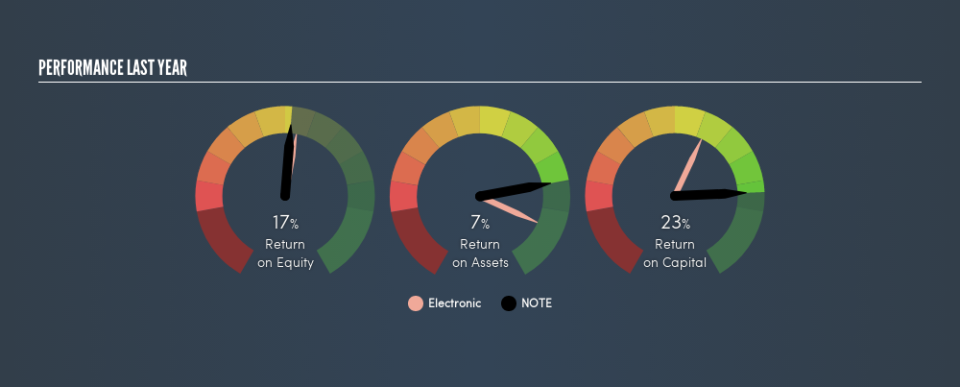Why You Should Like NOTE AB (publ)’s (STO:NOTE) ROCE

Today we’ll look at NOTE AB (publ) (STO:NOTE) and reflect on its potential as an investment. Specifically, we’re going to calculate its Return On Capital Employed (ROCE), in the hopes of getting some insight into the business.
First, we’ll go over how we calculate ROCE. Next, we’ll compare it to others in its industry. Last but not least, we’ll look at what impact its current liabilities have on its ROCE.
What is Return On Capital Employed (ROCE)?
ROCE is a metric for evaluating how much pre-tax income (in percentage terms) a company earns on the capital invested in its business. Generally speaking a higher ROCE is better. Ultimately, it is a useful but imperfect metric. Renowned investment researcher Michael Mauboussin has suggested that a high ROCE can indicate that ‘one dollar invested in the company generates value of more than one dollar’.
So, How Do We Calculate ROCE?
The formula for calculating the return on capital employed is:
Return on Capital Employed = Earnings Before Interest and Tax (EBIT) ÷ (Total Assets – Current Liabilities)
Or for NOTE:
0.23 = kr93m ÷ (kr965m – kr552m) (Based on the trailing twelve months to December 2018.)
Therefore, NOTE has an ROCE of 23%.
View our latest analysis for NOTE
Does NOTE Have A Good ROCE?
When making comparisons between similar businesses, investors may find ROCE useful. In our analysis, NOTE’s ROCE is meaningfully higher than the 18% average in the Electronic industry. We consider this a positive sign, because it suggests it uses capital more efficiently than similar companies. Putting aside its position relative to its industry for now, in absolute terms, NOTE’s ROCE is currently very good.
In our analysis, NOTE’s ROCE appears to be 23%, compared to 3 years ago, when its ROCE was 15%. This makes us think the business might be improving.
Remember that this metric is backwards looking – it shows what has happened in the past, and does not accurately predict the future. Companies in cyclical industries can be difficult to understand using ROCE, as returns typically look high during boom times, and low during busts. ROCE is, after all, simply a snap shot of a single year. How cyclical is NOTE? You can see for yourself by looking at this free graph of past earnings, revenue and cash flow.
Do NOTE’s Current Liabilities Skew Its ROCE?
Current liabilities are short term bills and invoices that need to be paid in 12 months or less. The ROCE equation subtracts current liabilities from capital employed, so a company with a lot of current liabilities appears to have less capital employed, and a higher ROCE than otherwise. To counter this, investors can check if a company has high current liabilities relative to total assets.
NOTE has total assets of kr965m and current liabilities of kr552m. As a result, its current liabilities are equal to approximately 57% of its total assets. While a high level of current liabilities boosts its ROCE, NOTE’s returns are still very good.
Our Take On NOTE’s ROCE
In my book, this business could be worthy of further research. Of course you might be able to find a better stock than NOTE. So you may wish to see this free collection of other companies that have grown earnings strongly.
If you are like me, then you will not want to miss this free list of growing companies that insiders are buying.
We aim to bring you long-term focused research analysis driven by fundamental data. Note that our analysis may not factor in the latest price-sensitive company announcements or qualitative material.
If you spot an error that warrants correction, please contact the editor at editorial-team@simplywallst.com. This article by Simply Wall St is general in nature. It does not constitute a recommendation to buy or sell any stock, and does not take account of your objectives, or your financial situation. Simply Wall St has no position in the stocks mentioned. Thank you for reading.

 Yahoo Finance
Yahoo Finance 
